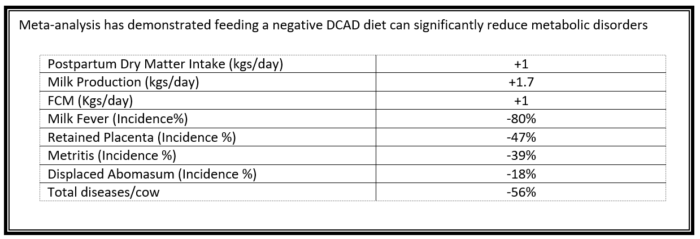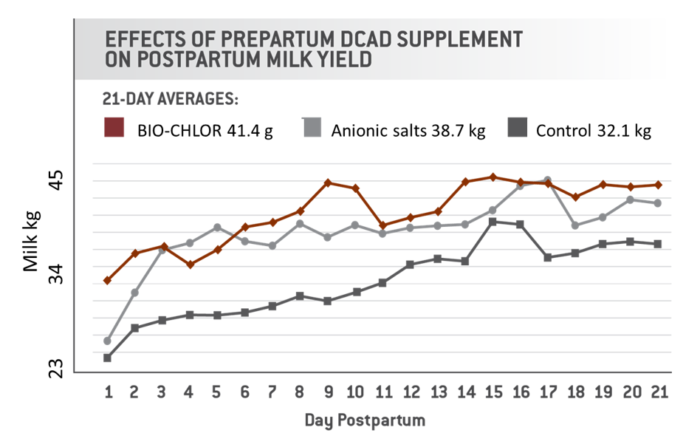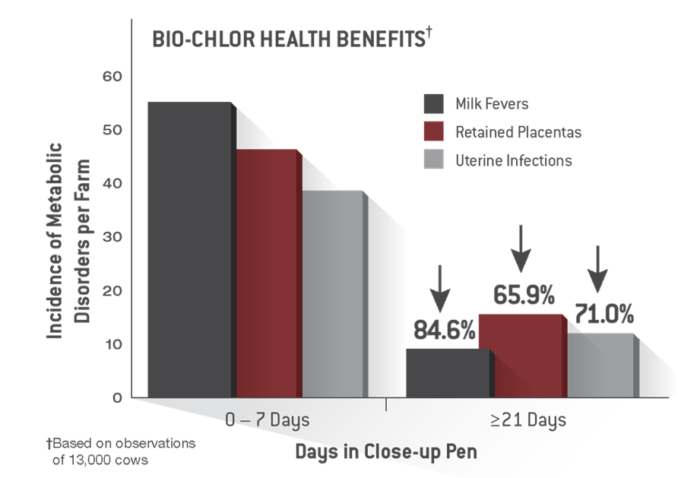Transition Dairy – feeding the transition cow to achieve success
Success in dairy farming includes managing all phases of production. Research and practice have shown that for maximum return, lactation management starts during the cows’ dry period, continues into transition with astute nutritional support that is maintained into lactation.
The ”transition period”, 60 days pre and post calving the most critical of which are the 21 days prior to calving, is time where a dairy can impact milk yields and reduce the incidence of metabolic disorders. Correct feeding and management during this period to ensure a higher DMI over transition supports both milk yield and body weight. Furthermore, minimising the duration the cows are in negative energy balance can also have a positive impact on subsequent reproduction success.
A negative cation-anion difference (DCAD) diet is a feeding strategy commonly employed 21 days prior to calving. This involves feeding a diet that is low in cations (sodium and potassium) and high in anions (chlorine and sulphur). The result is a net negative dietary DCAD which can have several benefits for transition dairy cows.
One benefit of feeding a negative DCAD diet to transition cows is that it can help to reduce the risk of post-calving milk fever1. Feeding a negative DCAD diet can help to maintain normal blood calcium levels and prevent milk fever by making bone calcium a more available supply to be drawn on when the cow needs it most. In addition to reduced milk fever meta-analysis has shown a reduction in other metabolic disorders1 such as retained placentas and reduced uterine infections. A further benefit of feeding a negative DCAD diet during transition is an increase in fresh milk yield1 when compared to a positive DCAD diet.
Figure 1 – Meta-analysis of 42 publications and 134 treatments displayed the disease and performance incidence change when prepartum DCAD was reduced from +20 to -10 meq/100g dry matter2
During the transition period, the protein requirements of dairy cows increase significantly due to the high demand for milk production and the need to rebuild body tissues after giving birth. As a lower DCAD diet can reduce DMI, supplying a highly-metabolisable protein source in the diet prior to calving can help mitigate some of the expected loss in milk yield. In fact, research3,4 has shown that using a highly metabolisable protein source (BIO-CHLOR) in combination with the negative DCAD fed 21 prepartum led to an additional 2.6Kg/day of ECM production over anionic salts treatment fed for the same duration and at the same negative DCAD (-10 DCAD mEq/100g DM). Both treatments recorded higher production over the control treatment (positive DCAD).
Figure 2 – Feeding a highly metabolisable protein source in combination with the negative DCAD during the 21 days prepartum leads to further increase in fresh milk yields over anionic salts alone.
Figure 2 – Impact of days in close up pen: In one research trial with over 13,000 observations, cows fed BIO-CHLOR for at least 21 days prepartum experienced significant health benefits over cows fed BIO-CHLOR for only 7 days or less5
Take Away Points:
- Management of the transition period is essential to ensure profitable production.
- Feeding a negative DCAD diet 21 days prior to calving can significantly reduce metabolic disorders associated with calving and increase fresh milk yield.
- Feeding a negative DCAD diet in combination with a highly metabolisable protein source (BIOCHLOR) 21 prior to calving can significantly reduce metabolic disorders associated with calving and further increase fresh milk yield.
Reference list:
- Diary Australia, A TECHNICAL REVIEW FOR NUTRITIONAL PROFESSIONALS, VETERINARIANS AND FARM ADVISERS, Second edition 2021 | Ian Lean and Peter DeGaris.
- Meta-analysis of the effects of prepartum dietary cation-anion difference on performance and health of dairy cows Santos JEP, Lean IJ, Golder H, and Block E. 2019. J Dairy Sci 102:2134-2454.
- DeGroot MA, Block E, French PD. Effect of prepartum anionic supplementation on periparturient feed intake, health, and milk production. J Dairy Sci 2010:5268-5279.
- Hoover W, Difference in feed intake pre- and postpartum, urine pH prepartum, and difference in production parameters postpartum for cows fed a control diet vs. a BIO-CHLOR containing diet (DCAD – 10 meq/100g DM) for 21 days pre-partum. ADSA Abstract, 1998.
- Corbett Corbett, R.B. 2002. Influence of days fed a close-up dry cow ration and heat stress on subsequent milk production in western dairy herds. Journal of Dairy Science 85 (Suppl. 1), 191.




